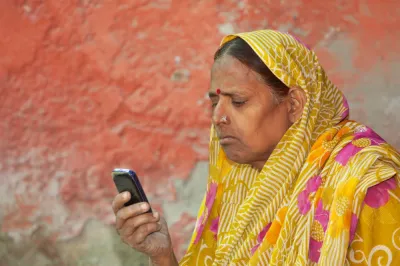Can Smartphone-Supported Behavioral Biometrics Advance Digital Financial Inclusion?

Biometric identification has emerged as an efficient and secure way to authenticate unbanked and underserved people’s identities and facilitate their access to financial services. Physiological biometrics, which is the most common method, uses biological measurement of internal and external structure of the human body (facial features, fingerprints, iris and retina patterns, hand geometry, vein pattern, DNA) to identify a person.
However, the use of physiological biometrics has several disadvantages:
- It requires technology-intensive, expensive equipment.
- Biometric devices are often cumbersome and not easily exploitable in remote locations with low-level infrastructure and poor connectivity, thereby undermining efforts to identify vulnerable populations most in need of ID.
- A biometric identification system stores a digital copy (template) of your face, iris or fingerprint image, raising concerns about privacy and protection of personal data.
On the other hand, behavioral biometrics leverages artificial intelligence and machine learning to examine patterns in behavioral attributes (voice patterns, keystroke dynamics, gait or posture, gesture sequences) to determine whether the person under consideration is really who they claim to be. This other method of biometric identification requires only a smartphone with integrated sensors to collect data following physical contact or nearby human action.

An illustration of the various integrated sensors in a current smartphone.
Source: Smartphone Sensors for Health Monitoring and Diagnosis, ResearchGate, 2019
This emerging technology presents the sector with exciting opportunities as well as challenges in the effort to advance digital financial inclusion in low-and-middle income countries.
Opportunities for behavioral biometrics to advance financial inclusion
Stronger security at lower cost
Behavioral biometrics has the potential to be the most cost-effective method for digital identification in low-income countries. Without the need to purchase and maintain the expensive equipment required for physiological biometrics, the economy of scale that can be achieved would be monumental for national digital identification campaigns. Widespread adoption of smartphone technology could enable self-authentication on a massive scale, facilitating access to digital financial services (DFS).
Behavioral biometric identification could be used in real time by DFS providers to provide enhanced security for authentication in a frictionless way. The technology employs continuous monitoring procedures that unobtrusively confirm the financial service user’s identity throughout the active session and not just at the time of entry. Behavioral biometrics also enables financial institutions to differentiate human-driven action from automated attacks and bots.
An example of a use case for smartphone-supported behavioral biometric identification:

Improved control and protection of personal data
Behavioral biometrics allows the highest form of control over personal data. As the identification solution taps into smartphones to authenticate users through the movements they make in their daily lives, it eliminates the necessity to provide personal data when going online. No authority or service provider would need to collect or share users’ physiological biometric data (fingerprints, facial image, iris scan, etc.), and there is no storage on a cloud. Consequently, there is zero risk of leaked personal data or misusage, like for political manipulation at the expense of populations at risk.
Maintaining vital services in a pandemic or other constrained context
The Covid-19 outbreak and its containment measures, including social distancing and glove and mask wearing, showed the limits of physiological biometric methods like fingerprint and facial recognition. In this type of constrained environment, when fingerprints cannot be used due to gloves, user authentication on smartphones could be done by using touchscreen swipe and keystroke patterns. Behavioral biometrics represent a potential solution for low-income countries to avoid interruption of identification-based lifeline services, such as social transfers, in the event of another pandemic.
Challenges for using behavioral biometrics for financial inclusion
However, stakeholders will need to overcome two main challenges.
Usefulness will be limited by a country’s level of DFS penetration, broadband connectivity and (compatible) smartphone adoption
To determine whether a country is ready to implement behavioral biometrics, there are three relevant ratios we could consider. The first two look at DFS penetration and the third measures smartphone adoption rates.
- Adults using digital payments ratio (from the G20 Financial Inclusion Indicators): To gauge how many people would benefit from this technology.
- Digital payments to or from enterprises ratio (from the G20 Financial Inclusion Indicators): The share of SMEs that already leverage digitization of financial transactions.
- Penetration of mobile users indicator (from the GSMA mobile connectivity index): For a snapshot of smartphone adoption among targeted populations.
The concept of behavioral biometrics applied to digital financial inclusion has yet to undergo thorough research, so forthcoming studies will be necessary to determine the appropriate metrics in a given context.
Furthermore, broadband connectivity in a country needs to be taken into account. Service providers must design financial services compatible with a low-to-average bandwidth (3G or even 2G network), to reach target populations who live in remote locations with poor connectivity.
Design communications with digital literacy and gender considerations
While it is easier for users to learn new procedures when it is done on a device they use daily like their smartphone, it is still essential to raise awareness among target populations about behavioral biometrics. Communication should focus on informed consent because smartphones are perceived as intimately personal devices. The fact that they collect personal characteristics could appear deeply intrusive to owners. Materials used for communication should also be tailored for gender considerations (for instance, promoting a positive image of women’s smartphone adoption), especially when services involve social transfers and account ownership.
Reshaping digital public infrastructure in low- and middle-income countries
Behavioral biometric identification is an emerging technology fostered by the global trend of continuous data exchange and we are starting to see more use cases emerge in developing countries. For example, India’s UPI recently launched “conversational payments,” which allow users to make payments via voice-based inputs, making the services more accessible. Of course, this innovation will need to implement balanced safeguards like voice authentication to mitigate the evolving risks.
As digital public infrastructure in developing countries grows, it will foster competition between DFS market players and they will be better able to leverage behavioral biometric systems. To build a comprehensive identity-based digital public infrastructure, a concerted strategy among stakeholders to opt for open-source solutions, leveraging interoperability through API integration, is essential.
Behavioral biometrics could thus advance financial inclusion while also providing greater security and data protection at lower cost.


